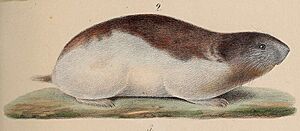Arctic lemming facts for kids
Quick facts for kids Arctic lemming |
|
|---|---|
 |
|
| Conservation status | |
| Scientific classification | |
| Genus: |
Dicrostonyx
|
| Species: |
torquatus
|
The Arctic lemming (Dicrostonyx torquatus) is a small rodent that lives in very cold places. It belongs to the same family as hamsters and voles, called Cricetidae.
Even though most Arctic lemmings are not in danger, one special type found on Novaya Zemlya islands is considered a vulnerable animal. This means it needs protection. It has been listed in the Red Book of the Russian Federation since 1998.
Arctic Lemming Life
The Arctic lemming lives only in the Arctic parts of Russia. It is the most common mammal on the Severnaya Zemlya islands. Long ago, these lemmings were also found in England, but they are now gone from there.
Lemmings from different groups can often live together. Arctic lemmings sometimes move to new places when there are too many of them in one area. They might even swim to find a new home.
When lemming numbers go down, it can affect other animals. For example, fewer lemmings can mean that geese and wading birds have fewer babies. When lemming numbers go up again, it helps these birds have more young. Lemmings often have their babies and raise them safely hidden in the snow.
What Arctic Lemmings Eat
Scientists have studied what Arctic lemmings eat. Most of their diet, about 86%, comes from plants with two seed leaves, like willows. About 14% of their food is from plants with one seed leaf, like grasses. They eat very little moss, less than 1%.
Lemmings and Predators
Arctic lemmings are a good example of how predators and their prey affect each other. For instance, Arctic terns hunt lemmings. When terns attack, lemmings try to hide in holes or other safe spots to avoid being caught.
Their Environment
During the cold winter, Arctic lemmings build nests. These nests help them stay warm and protect their young. They also help lemmings survive attacks from predators.
One of their main predators is the Arctic Fox. It can be hard for foxes to hunt lemmings because the lemmings dig deep tunnels in the snow. The fox then has to dig through the snow to reach them.
However, if there isn't much snow, lemmings have trouble building nests or digging tunnels. When this happens, their numbers can drop because they cannot protect themselves from predators.


